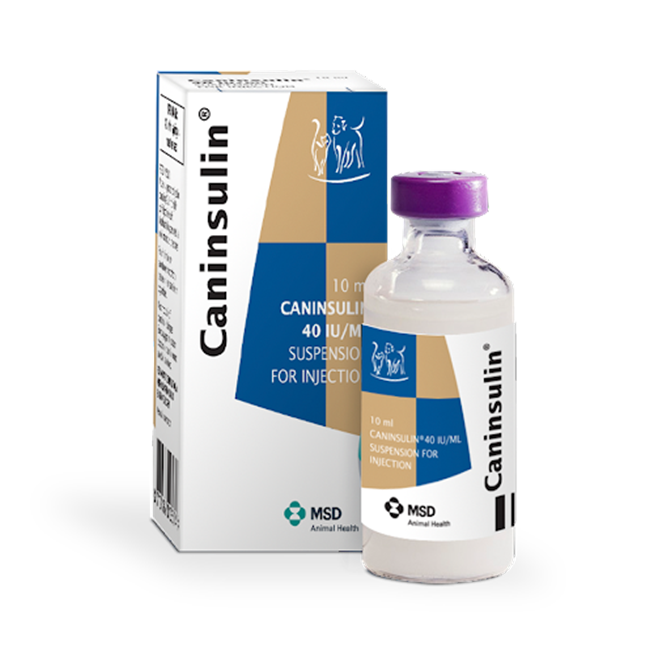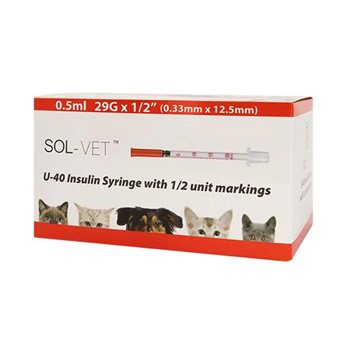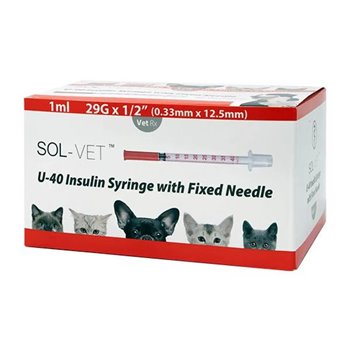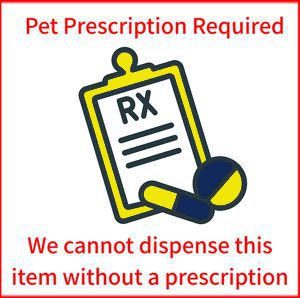
Caninsulin for Dogs Insulin Diabetes - 10ml 40u/ml
51342
10ml Vial - Caninsulin is an intermediate acting insulin product used in cases of diabetes mellitus. VET PRESCRIPTION REQUIRED
Product Features
- Pack Size: - Sold Individually
- Target Animal: - Dog (Canine)
- Pet Prescription Required?: - Yes (For UK Orders)
- Active Ingredient: - Insulin
- Product Name: - Caninsulin for Dogs Insulin Diabetes - 10ml 40u/ml
More Information
Description
This medication may only be supplied with a valid veterinary prescription issued by your vet. You should only purchase this item if you have or are in the process of arranging such a prescription. See information bar for further details.
Caninsulin - Insulin suspension for injection containing 40 IU per ml of highly purified porcine insulin 30% of which is amorphous zinc insulin and 70% crystalline zinc insulin. Methylparahydroxybenzoate 0.1% w/v is present as a preservative.
Caninsulin is an intermediate acting insulin product containing porcine insulin which is structurally identical to canine insulin. It is indicated in cases of diabetes mellitus (insulin deficiency) in dogs and cats where the required blood levels are achieved by using an individually adjusted dose of Caninsulin.
Dosage and administration
An insulin-syringe with insulin unit markings for a 40 IU/ml solution must be used. Caninsulin should be administered once or twice daily as appropriate by subcutaneous injection. Alternate the injection site daily. Invert the vial a few times before use until a homogenous suspension is obtained. A once daily injection is sufficient to reduce the blood glucose concentration in most diabetic dogs. However the duration of action may vary making it necessary to administer the insulin dose twice daily to some diabetic dogs. In diabetic cats it is necessary to administer Caninsulin twice daily. The dose depends on the degree of deficit in the animal`s own insulin production and is therefore different in each case. Stabilisation phase Dog: Insulin therapy is initiated with the starting dose of 0.5 to 1.0 IU/kg bodyweight once daily rounded down to the lowest entire number of units. Subsequent adjustment to establish the maintenance dose should be made by increasing or decreasing the daily dose by approximately 10% according to the evolution of the diabetes clinical signs and to the results of serial blood glucose measurement.
Alterations in dose should not normally be made more frequently than every 3 days. The duration of insulin action as determined by blood glucose curve may require treatment to be administered twice daily. In such cases the dose per injection must be decreased by 25% so that the total daily dose is less than doubled. For example for a 10 kg dog receiving 5 IU once daily the new dose (rounded down to the nearest whole unit) would be 3 IU per injection initially. The new doses should be administered at 12-hour intervals. Further dose adjustments should be made progressively as previously explained. Following switching to twice daily dosing it is recommended that the clinical signs and blood glucose response be monitored closely. To achieve a balance between the generation of glucose and the effect of the product feeding should be synchronized with the treatment and the daily ration divided into two meals.
The composition and quantity of the daily food intake should be constant. In dogs treated once daily the second meal is usually fed at the time of peak insulin effect. In dogs treated twice daily feeding coincides with Caninsulin administration. Each meal should be fed at the same time each day. Cat: The initial dose is 1 IU or 2 IU per injection based on the baseline blood glucose concentration as presented in the following table. Cats require twice daily administration. Cat blood glucose concentration Starting dose per cat <20 mmol/l or < 3.6�g/l (<360�mg/dl) 1 IU twice daily =20 mmol/l or = 3.6�g/l (=360�mg/dl) 2 IU twice daily The starting dose should not exceed 2 IU per injection. The composition and quantity of the daily food intake should be constant. Subsequent adjustment to establish the maintenance dose should be made by increasing or decreasing the daily dose according to the results of serial blood glucose measurement. Alterations in dose should not normally be made more frequently than every week. Increments of 1 IU per injection are recommended. Due to the day-to-day variation in the blood glucose response and the variations in insulin responsiveness that are seen with time larger or more frequent increases in dose are not recommended.
Maintenance phase in dogs and cats
Once the maintenance dose has been reached and the animal is stabilised a long term management program needs to be established. The aim should be to manage the animal in such a way as to minimize the variations in its insulin requirement. This includes clinical monitoring to detect under or over dosage of insulin and adjustment of dose if required. Careful stabilisation and monitoring will help to limit the chronic problems associated with diabetes including cataracts (dogs) fatty liver (dogs and cats) etc. Follow up examinations should be performed every 2-4 months (or more often if there are problems) to monitor the animal?s health the owner?s records and biochemical parameters (like blood glucose and/or fructosamine concentration). Adjustments to the insulin dose should be made based on interpretation of the clinical signs supported by the laboratory results. Somogyi overswing also called rebound hyperglycaemia is a response to an overdose of insulin insufficient to cause potentially fatal hypoglycaemia. As hypoglycaemia begins to develop a hormonal response is triggered which results in the release of glucose from hepatic glycogen stores. This results in rebound hyperglycaemia which may also manifest as glycosuria for part of the 24-hour cycle. There is a danger that the Somogyi overswing is interpreted as a requirement for increase in the insulin dose rather than a decrease. This can be avoided by basing decisions on serial blood glucose measurements rather than single point measurements. The ability of pet owners to recognize the signs of hypo- or hyperglycaemia and respond appropriately is very important. For any information about this veterinary medicinal product please contact the local representative of the marketing authorisation holder. �
Contra-indications warnings etc
Caninsulin must not be administered by the intravenous route. The product is a medium duration insulin and is not intended for the treatment of animals with severe acute diabetes presenting in a ketoacidotic state. Local injection site reactions have been reported rarely in dogs and very rarely in cats. These reactions are usually mild and reversible. In very rare cases allergic reactions to porcine insulin have been reported. In the cat diabetic remission is possible. Before the product is administered owners should be instructed to have a box of powdered glucose at home. Signs of hunger increasing anxiety unstable locomotion muscle twitching stumbling or sinking in the rear legs and disorientation indicate progression of hypoglycaemia and requires immediate administration of glucose solution and food to restore blood glucose levels. Polyuria polydipsia and polyphagia in combination in chronic cases with weight loss general bad condition loss of hair or abnormal furry coat and lethargy are the most common clinical symptoms of hyperglycaemia and require administration of insulin to restore blood glucose levels to the normal range. The use of progestagens (oestrus inhibitors) in patients suffering from diabetes mellitus should be avoided. Stress and irregular extra exercise must be avoided. Care must be taken with the use of corticosteroids. Ovariohysterectomy may have to be considered. It is important to establish a strict feeding schedule in consultation with the owner which will include a minimum of fluctuations and changes. Administration of the product must be carried out by an adult responsible for the welfare of the animal. The use of the product is not contra-indicated during pregnancy or lactation but requires close veterinary supervision to account for changes in metabolic requirements during this period. Changes in insulin requirements may result from administration of substances which alter glucose tolerance such as corticosteroids thiazide diuretics progestogens amitraz and alpha-2 agonists such as medetomidine dexmedetomidine xylazine. Monitoring of glucose concentrations should be used to adjust the dose accordingly. Similarly changes in diet or exercise may alter insulin requirements.
User warnings
Accidental self-injection can provoke clinical signs of hypoglycaemia and there is a low possibility of an allergic reaction. In case of accidental self-injection seek medical advice immediately and show the package leaflet to the doctor. Withdrawal period Not applicable. For animal treatment only. Keep out of reach and sight of children. � Pharmaceutical precautions Before opening store upright and refrigerated between +2 and 8?C. Protect from light. Do not freeze. After first opening either store refrigerated between +2 and 8?C or not above 25?C. Following withdrawal of the first dose use the product within 28 days. Disposal advice Dispose of used packaging in the household refuse. Unused product should be returned to the veterinary surgeon or a local pharmacy.
Legal category
Caninsulin is a POM-V (Pet Prescription Required)
You may also like

Caninsulin Syringes 0.5ml - Pack of 30
***Please note*** These will temporarily be substituted with SOL-M syringes due to a long term manufacturer's shortage, but will be identical. Syringes with needles for use with Caninsulin insulin

Caninsulin Syringes 1ml - Pack of 30
***Please note*** These will temporarily be substituted with 30 SOL-M syringes due to a long term manufacturer's shortage, but will be identical. Syringes with needles for use with Caninsulin insulin





